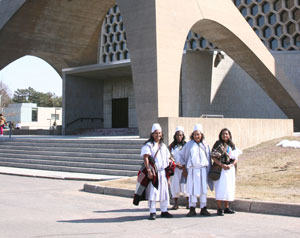From the mountains of Colombia to the campuses of CSB and SJU
Arhuacos tribe brings a message of preservation and sustainability
April 19, 2011
By Emily Bina '11

Ecosofia, in Spanish, is the philosophy of ecology. In the Arhuaco community, it's a way of life.
The Arhuacos, an indigenous tribe from the mountains of Colombia, have a message of preservation and sustainability for the environment. They consider themselves an "Elder Brother" to the rest of the world: a group to be looked up and listened to like an older sibling might be.
CSB and SJU and surrounding community members were definitely listening when four Arhuacos tribe members visited the campuses April 3-8.
"We want to represent ourselves how we see us, not how the world sees us,"
Moises Villafañe Izquierdo explained, referring to the tribe's newer inclusions of formal education and travel.
Villafañe Izquierdo was the spokesperson for the Arhuacos' visit to CSB and SJU, as he speaks both Spanish and their native "Ika" language. Three-way translations made the process slow, though the point was clear.
"We must all be protagonists of our own history," he said, explaining that passivity would not preserve the Earth, his message, or his people.
The preservation of people is something the Arhuacos know from experience.
The Arhuaco Tribe is one of the last surviving indigenous tribes of the Spanish conquest. They live in the Sierra Nevada Mountains in Colombia, an area known as a microcosm of the world because every single ecosystem can be found there - from desserts to artic temperatures, and everything in between.
Word of the Arhuacos ecosofia first came in 1992, when the BBC produced a documentary called "From the Heart of the World: The Elder Brother's Warning" about the neighboring Kogi Tribe. Since then, the Arhuacos, whose population is nearly 27,000, have made more efforts to spread the message of environmental preservation and harmony with the Earth.
And while the Arhuacos have always lived by a rule of preservation, they're not the only community getting involved.
During the 2010-11 school year, CSB and SJU have been celebrating the "Year of Sustainability," and have already made changes that are preservation-based and sustainability-minded.
So far, the schools have implemented online bill payment to save money and eliminate paper waste; stocked both bookstores with environmentally friendly products; incorporated Arboretum visits into early classroom learning; and stationed eco-representatives in several decision-making organizations.
Of course, the "Year of Sustainability" doesn't just end with the finish of the academic year. Already environmentally conscious building designs have been approved for the CSB and SJU campuses, making sure students and the Earth can both prosper.
But preservation practices won't be the only life lesson students will finish with in four years. If they're lucky, they'll learn perseverance, too.
Sarah Schwalbach, a senior communication and Hispanic Studies double major, was one of the students who organized to get the Arhuacos on campus, and what started as a capstone project turned into something much bigger.
"When I started researching, I realized that if the Arhuacos came not only to Minnesota, but to campus, it would be much bigger than a capstone project, and it would take more than just me."
Schwalbach was right. It took one full year and plenty collaboration from Amnesty International and Myriam Mansell - a Spanish teacher at Cathedral High School in St. Cloud, a CSB alumna and friend of this indigenous people. On April 3, the Arhuacos arrived, their all-white outfits matching the remaining piles of Minnesota snow.
"They stepped off the plane and I realized what was happening was really making history," Schwalbach said.
History, of course, for both the institutions and for the Arhuacos. Two of the four visiting tribe members had never left the Sierra Nevada Mountains, let alone Colombia.
And while the Arhuaco people live thousands of miles away on an isolated mountain, their message is a shared one.
"We breathe the same air, drink the same water," Villafañe Izquierdo said. "We are not as different as we think."
